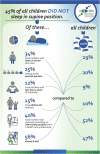Prevalence and associated factors of supine sleep position in 3-month-old infants: findings from the 2015 Pelotas (Brazil) Birth Cohort
- PMID: 31126263
- PMCID: PMC6533648
- DOI: 10.1186/s12887-019-1534-3
Prevalence and associated factors of supine sleep position in 3-month-old infants: findings from the 2015 Pelotas (Brazil) Birth Cohort
Abstract
Background: Non-supine infant sleep position is an important modifiable risk factor for sudden unexpected death in infancy. The aim of this study was to assess the prevalence of supine sleep position and associated factors among 3-month-old infants from a birth cohort in the city of Pelotas, southern Brazil.
Methods: The present study evaluated longitudinal data from the 2015 Pelotas Birth Cohort. Study outcome was supine infant sleep position, defined as the appropriate position, among 3-month-old children. Demographic, socioeconomic, behavioral, and health characteristics collected at birth and at the 3-month follow-up were investigated as possible associated factors. The prevalence of each associated factor was investigated, and crude and hierarchical adjusted analyses were performed using Poisson regression.
Results: Among the 4108 infants assessed in this study, 2274 (55.4%) slept in supine position at 3 months and only 66 (1.6%) in prone position. Maternal white skin color, higher family income and maternal schooling, advanced maternal age, maternal cohabiting with a partner, receiving counseling from health care professionals and non-bed-sharing were associated with higher prevalence of infants sleeping in supine position at 3 months. All these variables remained associated in our hierarchical adjusted analyses except maternal cohabitation with a partner. Participants with white mothers were more likely to sleep in supine position (PR: 1.23; 95%CI: 0.75-0.89) compared to participants with black mothers. Those belonging to the richest quintile were more likely to sleep in supine position (PR: 1.49; 95%CI: 1.35-1.65) compared to those who belong to the poorest. Mothers aged 31-36 years were more likely to choose supine sleep position (PR: 1.65; 95%CI: 1.42-1.92) compared to mothers younger than 19 years.
Conclusions: The findings of the present study showed the influence of maternal age, socioeconomic status, and counseling on infant sleep habits as predictors of choice of infant sleep position in a Brazilian population. It is recommended to implement informative campaigns and public policies to at-risk population and to improve recommendations from health care professionals.
Keywords: Brazil; Cohort studies; Epidemiology; Infant; Infant sleep position; Public health; Sudden infant death.
Conflict of interest statement
The authors declare that they have no competing interests.
Figures
References
-
- Galland BC, Elder DE. Sudden unexpected death in infancy: biological mechanisms. Paediatr Respir Rev. 2014;15:287–292. - PubMed
-
- Stanley FJ, Byard RW. The association between the prone sleeping position and sudden infant death syndrome (SIDS): an editorial overview. J PaediatrChild Health. 1991;27:325–328. - PubMed
Publication types
MeSH terms
Grants and funding
LinkOut - more resources
Full Text Sources
Medical
Research Materials


